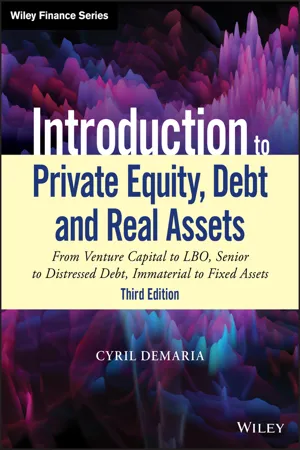
Introduction to Private Equity, Debt and Real Assets
From Venture Capital to LBO, Senior to Distressed Debt, Immaterial to Fixed Assets
- English
- ePUB (mobile friendly)
- Available on iOS & Android
Introduction to Private Equity, Debt and Real Assets
From Venture Capital to LBO, Senior to Distressed Debt, Immaterial to Fixed Assets
About This Book
Fully revised and updated to reflect changes in the private equity sector
Building on and refining the content of previous editions, Introduction to Private Equity, Debt and Real Assets, Third Edition adopts the same logical, systematic, factual and long-term perspective on private markets (private equity, private debt and private real assets) combining academic rigour with extensive practical experience.
The content has been fully revised to reflect developments and innovations in private markets, exploring new strategies, changes in structuring and the drive of new regulations. New sections have been added, covering fund raising and fund analysis, portfolio construction and risk measurement, as well as liquidity and start-up analysis. In addition, private debt and private real assets are given greater focus, with two new chapters analysing the current state of these evolving sectors.
• Reflects the dramatic changes that have affected the private market industry, which is evolving rapidly, internationalizing and maturing fast
• Provides a clear, synthetic and critical perspective of the industry from a professional who has worked at many levels within the industry
• Approaches the private markets sector top-down, to provide a sense of its evolution and how the current situation has been built
• Details the interrelations between investors, funds, fund managers and entrepreneurs
This book provides a balanced perspective on the corporate governance challenges affecting the industry and draws perspectives on the evolution of the sector.
Frequently asked questions
PART I
What are Private Equity, Private Debt and Private Real Assets?
NOTES
- 1 For example, in Spain there has been a debate since, after the 2007–2009 crisis, loans are not covered if assets have depreciated. Thus, borrowers have lost their assets pledged as collateral and still owe money to the banks.
- 2 According to The Economist (15 December 2012), in the USA, banks are responsible for 25–30% of total lending. In Europe, 95% of total lending comes from commercial banks.
CHAPTER 1
Private Equity as an Economic Driver: An Historical Perspective
Table of contents
- Cover
- Table of Contents
- Acknowledgements
- About the Author
- Introduction
- PART I: What are Private Equity, Private Debt and Private Real Assets?
- PART II: The Private Markets Ecosystem
- PART III: Private Markets in Teenage Time
- Template 1 (Fund): Architecture of the Private Placement Memorandum of a Private Equity Fund
- Template 2 (Fund): Structure of a Limited Partnership Agreement
- Template 3 (Fund): Due Diligence Checklist
- Template 4 (Fund): Quarterly Report Template
- Template 5 (Company): Non-Disclosure Agreement
- Template 6 (Company): Business Plan
- Template 7 (Company): Term Sheet
- Exhibits
- Glossary
- Bibliography
- Index
- End User License Agreement